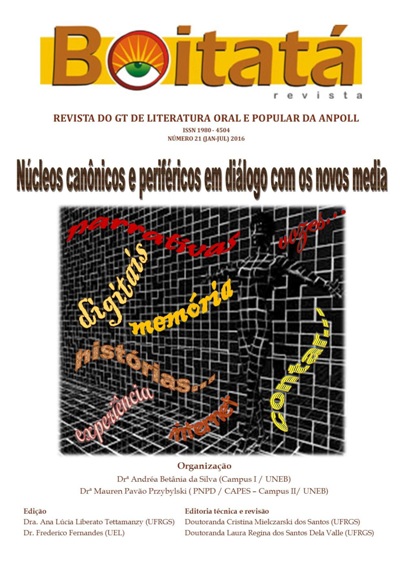The voice of the underground in the performance of Catira
DOI:
https://doi.org/10.5433/boitata.2016v11.e31257Keywords:
Catira, Performance, Folklore, Artistic expression, Hick, Dance,Abstract
The purpose of this article is to try to identify the voice of the hick singer in catira performances. Of course, this dance that has existed for centuries can be considered a hick shape expresses his indignation, his anger, his joy and his love. However, there is no room for these claims in large urban centers, and their notes end up not having much relevance. If we do Gayatri Spivak question "Can the subaltern speak?" At first, and considering this hick a subaltern, we can say that in catira performances he speaks, yes, but we cannot say whether he is being heard. When we speak of "being heard" here it is not just the hearing question, but to be relieved, his voice echoing off the field and their songs be considered at least as music, not just a naive cultural event.References
ARAÚJO, Alceu Maynard. Folclore Nacional. 2. ed. São Paulo: Editora Melhoramentos, 1967. v. 2
CANCLINI, Nestor Garcia. Culturas híbridas: estratégias para entrar e sair da Modernidade. 3 ed. Tradução de Heloisa Pezza Cintrão e Ana Regina Lessa. São Paulo: EDUSP, 2000.
CASCUDO, Luís de Câmara. Dicionário do Folclore Brasileiro. Rio de Janeiro: Instituto Nacional do Livro, 1954.
COMPAGNON, Antoine. O demônio da teoria: literatura e senso comum. 2. ed. Tradução de Cleonice Paes Barreto Mourão e Consuelo Fortes Santiago. Belo Horizonte: Ed. UFMG, 2010.
Dicionário Houaiss da Língua Portuguesa. Instituto Antônio Houaiss. Rio de Janeiro: Objetiva, 2001.
EAGLETON, Terry. Teoria da literatura: uma introdução. 3. ed. Tradução de Waltensir Dutra. São Paulo: Martins Fontes, 1997.
FERNANDES, Frederico Augusto Garcia. A voz e o sentido: poesia oral em sincronia. São Paulo: Ed. UNESP, 2007a.
FERNANDES, Frederico Augusto Garcia. Oralidade e Literatura 2: práticas culturais, históricas e da voz. Frederico Fernandes e Eudes Fernandes (Orgs.). Londrina: EDUEL, 2007b.
FERNANDES, Frederico Augusto Garcia. Oralidade e Literatura: manifestações e abordagens no Brasil. Frederico Augusto Garcia Fernandes (Org.). Londrina: EDUEL, 2003.
MAGALHÃES, Couto. Anchieta, as raças e línguas indígenas. São Paulo: C. Gerke, 1897.
RESENDE, Lisete et al. Catira: uma tradição de 450 anos. Uberaba: Fundação Cultural de Uberaba, 2014.
SPIVAK, Gayatri Chakravorty. Pode o subalterno falar? Tradução de Sandra Regina Goulart Almeida, Marcos Pereira Feitosa e André Pereira Feitosa. Belo Horizonte: Editora UFMG, 2010.
ZUMTHOR, Paul. A letra e a voz. Tradução de Amálio Pinheiro e Jerusa Pires Ferreira. São Paulo: Companhia das Letras, 1993.
ZUMTHOR, Paul. Introdução à poesia oral. Tradução de Jerusa Pires Ferreira et al. São Paulo: Hucitec/EDUC, 1997.
ZUMTHOR, Paul. Performance, recepção, leitura. 2. ed. Tradução de Jerusa Pires Ferreira e Suely Fenerich. São Paulo: Cosac Naify, 2007.
Downloads
Published
How to Cite
Issue
Section
License
Copyright (c) 2016 Boitatá

This work is licensed under a Creative Commons Attribution 4.0 International License.
Boitatá esta licenciada com CC BY sob essa licença é possível: Compartilhar - copiar e redistribuir o material em qualquer suporte ou formato. Adaptar - remixar, transformar, e criar a partir do material, atribuindo o devido crédito e prover um link para a licença e indicar se mudanças foram feitas.




















